Technical
Mercedes-Benz Flags the End of the Manual Transmission
In news that will send a shiver down the spine of motoring purists, Mercedes-Benz has signalled the end is nigh for the beloved manual transmission.
That’s according to Mercedes-Benz’s head of innovative work, Markus Schaefer, who made the comments suggesting curtains were drawing near as the brand shifts its attention to electrifying its vehicle line-up.
The German manufacturer will produce six models under the EQ badge, furthering its focus on a format that has yet to gain traction, but is seen as the ‘future’. Among its combustion line-up, plug-in hybrids are set to fill the void as combustion engines are consolidated across a series of Mercedes-Benz platforms.
At the heart of the decision is a drive by the company to reduce costs by standardising architecture across the company. In effect, Mercedes-Benz is promoting a modular strategy, which will limit variations between models, but help to keep manufacturing costs in check to support funding elsewhere.

Were the clues already in place?
The move away from manual has arguably been in the works for some time now. Among Mercedes-Benz’s current international line-up, larger variants have long been confined to automatic transmissions. Only a few cars have been fitted with a manual transmission, mostly entry-level variants in the A and C Class ranges. Closer to home, and the entire breadth of Mercedes-Benz’s passenger vehicle series is fitted with an automatic transmission.
You certainly can’t say the writing hasn’t been on the wall for a while now.
The bigger question from here on in, however, will be what impact this move has on the broader new car industry. Are we set to see an increasing number of manufacturers abandon the manual format in favour of a simpler set-up, thereby standardising combustion vehicle architecture in order to focus on electric vehicle research and development.
Only time will tell, but this may just be the beginning of an industry-wide trend.
Peugeot Sport Engineering: 508 Goes Hybrid.
Peugeot is undergoing a quiet evolution. Their stunning 508 sedan/coupe and wagon has been given the hybrid tick and along with the engine change comes a name change. Peugeot Sport Engineered is the monicker to be given to the range. The drivetrain that will be slotted into the Peugeot 508 Sport Engineered is a 147kW/300Nm 1.6L turbo four and a pair of electric motors. There is 81kW for the front, 83kW for the rear, making the vehicle a proper all wheel drive and being driven by 265kW and 520 Nm. Packaging sees the cargo space for both body styles unchanged. The transmission is an eight speed auto. Sink the slipper and 100kph comes up in 5.2 seconds, and the top speed is an electronically limited 250kph. Need some overtaking ability? 80kph to 120kph is seen in just three seconds.
The drivetrain that will be slotted into the Peugeot 508 Sport Engineered is a 147kW/300Nm 1.6L turbo four and a pair of electric motors. There is 81kW for the front, 83kW for the rear, making the vehicle a proper all wheel drive and being driven by 265kW and 520 Nm. Packaging sees the cargo space for both body styles unchanged. The transmission is an eight speed auto. Sink the slipper and 100kph comes up in 5.2 seconds, and the top speed is an electronically limited 250kph. Need some overtaking ability? 80kph to 120kph is seen in just three seconds.
The plug-in hybrid’s system sees an 11.5kWh battery fitted and using a standard 240V house socket should be charged in around seven hours. Factor in a 32A wallbox and that drops down to under two hours, or install a 16A plug system and that’s a good average of around 4 hours or less. Utilising the urge comes down to choosing from one of five drive modes. Sport takes a fully charged battery, and adjusts the dampers, engine, and transmission into the most energetic drive modes. Electric is a pure battery drive and offers a range of just over 40 kilometres, whilst disabling the 1.6-T at velocities of up to 140kph. Comfort is what the name suggests, with a cushy, plush ride, Hybrid uses both battery and petrol for an optimal drive, with the all-wheel drive mode more for those slipperier roads. Ride is helped by those adaptive dampers, a track change of 24mm front and 12mm rear, with 380mm font discs being slowed by four piston pads. 20 inch alloys hold on to Michelin Pilot Sport 4S rubber.
Utilising the urge comes down to choosing from one of five drive modes. Sport takes a fully charged battery, and adjusts the dampers, engine, and transmission into the most energetic drive modes. Electric is a pure battery drive and offers a range of just over 40 kilometres, whilst disabling the 1.6-T at velocities of up to 140kph. Comfort is what the name suggests, with a cushy, plush ride, Hybrid uses both battery and petrol for an optimal drive, with the all-wheel drive mode more for those slipperier roads. Ride is helped by those adaptive dampers, a track change of 24mm front and 12mm rear, with 380mm font discs being slowed by four piston pads. 20 inch alloys hold on to Michelin Pilot Sport 4S rubber.
Defining the look of the 508 Sport Engineered is an upgraded interior featuring Peugeot’s ubiquitous flat-bottomed tiller, the beautiful i-cockpit with 12.3 inch LCD screen, a premium audio setup from Focal, and a 10.0 inch main touchscreen. Leather “comfort-fit” seats with a 3D looking mesh cosset the passengers and the driver keep an eye on info via a HUD. Safety will include AEB, Lane Departure Warning, and night vision cameras. There is a bespoke grille, a redesigned front bumper with new air scoops in the lower corners, blackened exhaust tips, a rear diffuser and winglets front and rear. Selenium Grey, Pearl White, and Perla Nera Black will be the colours available.
There is a bespoke grille, a redesigned front bumper with new air scoops in the lower corners, blackened exhaust tips, a rear diffuser and winglets front and rear. Selenium Grey, Pearl White, and Perla Nera Black will be the colours available.
Peugeot Australia has not yet confirmed availability for Australia but a spokesman said local availability is being looked at.
An Automated Way of Life

Instead of a person performing tasks like accelerating, braking, turning or changing lanes, an autonomous vehicle uses its sophisticated vehicle computer system to calculate, monitor and perform these everyday driving tasks itself. Australian governments are working together to make sure that automated/autonomous vehicles can be legally and safely used when they are available for purchase in Australia. Already today, some new cars have automated features such as self-parking, active cruise control or lane-keep assist. These features assist the driver with driving, but a licensed human driver is still in control of the car. Over the next few decades vehicles will likely become increasingly automated, and eventually a human will not need to drive a car at all. Think of the road network of the future being a giant computer programme that is performing the road transport requirements for the people.
Whether we like it or not, the onset of automated vehicles is upon us. In fact, in America, automatic road trains/trucks to get goods from one depot to the next is already reality. Several companies, including Aurora, Daimler, and Embark Trucks, are competing for a slice of the future of self-driving freight trucks. Waymo is also expanding its own self-driving trucking routes throughout the American Southwest and Texas, following previous tests in Arizona, California, Michigan, and Georgia. This long-haul automated trucking works well in America, and it could be key for Australian trucking companies in the near future. While most of the current use has been on iron ore and coal mines, the roll-out of autonomous fleets in Australia is spreading. Newmont, Australia recently announced plans to make the Boddington mine the world’s first open-pit gold mine with an autonomous haul truck fleet.
So maybe the order of automation roll-out might be trucks first along with public transport, and then private vehicles to follow? The implementation of autonomous vehicles isn’t a cheap dream. Understandably, the level of research and development, as costly as it is, is so important to ensure all road users remain safe in-and around an autonomous vehicle. The sort of research and development needed for safety reasons costs loads of money, and this (as always), along with the requirement of actually keeping people safe while implementing the use of autonomous vehicles, are the real brakes on the realization of the dream for complete global autonomous vehicles. But is that just the tip of the iceberg?
Autonomous vehicles obtain emerging technologies that can potentially disrupt cities, economies, infrastructure and the way we do life together. Add those truths into the mix and we can see what a phenomenally expensive, chaotic and disruptive new technology this is, but the actuality of total autonomous transport could be astounding! Not something that’s everyone’s cup of tea but definitely worthy of at least partial implementation. Maybe that’s the way it is going to be introduced, subtly and gradually over time so people can get used to paying for it as well as using it.
Big Boots Matter
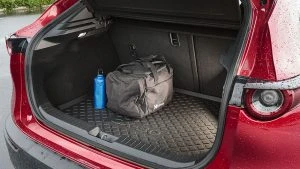
Luggage Space
If size matters to you when it comes to what you can (or can’t) fit in your boot, then how much space is commonly available in popular new car buys? The chances are you’ll want to know, so first are some of the most popular vehicles bought in Australia and their boot volume (litres). All the vehicles listed have their rear seats in place, because we all know the greatest vehicles carry a decent amount of luggage without having to flip their rear seats flat. There’s nothing worse than telling little Johnny that he can’t travel with his mates because the split folding rear seats have been split folded to take the school camp food!
At the end is a list of the best picks for carrying 550 litres or more behind the rear seats. You might be surprised, or not…
Supermini
Average boot space: 340.88 litres
1/ Renault Clio – 395 litres
2/ Honda Jazz – 354 litres
3/ Volkswagen Polo – 351 litres
Audi A1 – 335 litres
Skoda Fabia – 330 litres
Hyundai i20 – 326 litres
Kia Rio – 325 litres
Peugeot 208 – 311 litres
Hatchbacks
Average boot space: 479.40 litres
1/ Skoda Octavia 590 litres
2/ Peugeot 308 501 litres
3/ Honda Civic 492 litres
Renault Megane 434
VW Golf 380 litres
Small 4-door sedan
Average boot space: 464.75 litres
1/ Honda City | 536 litres
2/ Honda Civic | 519 litres
3/ Renault Megane | 503 litres
Kia Cerato | 502 litres
Toyota Corolla | 470 litres
Hyundai Accent Sport | 465 litres
Hyundai Elantra | 458 litres
Holden Astra | 445 litres
Mazda 3 444 litres
Audi A3 | 425 litres
Mazda 2 410 litres
Mitsubishi Lancer | 400 litres
Medium 4-Door Sedan
Average boot space: 501.82 litres
1/ Volkswagen Passat | 586 litres
2/ Skoda Octavia | 568 litres
3/ Toyota Camry | 524 litres
Kia Optima | 510 litres
Hyundai Sonata | 510 litres
Subaru Liberty | 493 litres
BMW 3 Series | 480 litres
Mazda 6 | 474 litres
Subaru Impreza | 460 litres
Ford Mondeo | 458 litres
Honda Accord | 457 litres
Large 4-Door Sedan
Average boot space: 509.2 litres
1/ Skoda Superb | 625 litres
2/ Volkswagen Arteon | 563 litres
3/ Holden Commodore | 490 litres
Chrysler 300 | 462 litres
Kia Stinger | 406 litres
Station wagons
Average boot space: 560.9 litres
1/ Holden Sportwagon 895 litres
2/ Skoda Superb 660 litres
3/ Peugeot 308 SW 660 litres
Ford Focus SW 608 litres
VW Golf SW 605 litres
Hyundai i30 SW 602 litres
Audi A6 SW 586 litres
Volvo V70 575 litres
BMW 5-Series SW 570 litres
Jaguar XF SW 565 litres
Kia Optima SW 552 litres
Ford Mondeo 541 litres
Mercedes Benz E-Class 540 litres
Subaru Levorg 522 litres
Mazda 6 SW 522 litres
Renault Megane SW 521 litres
Subaru Outback 512 litres
Peugeot 407 430 litres
Toyota Corolla SW 392 litres
Mini Clubman SW 360 litres
SUVs
LIGHT SUVs
Average boot space: 346.2 litres
1/ Citroen C3 Aircross – 410 litres
2/ Holden Trax – 356 litres
3/ Hyundai Venue 355 litres
Ford EcoSport – 346 litres
Mazda CX-3 264 litres
SMALL SUVs
Average boot space: 385.91 litres
1/ Jeep Compass 438 litres
2/ Honda HR-V 437 litres
3/ Kia Seltos 433 litres
Nissan Qashqai 430 litres
Renault Kadjar 408 litres
Mitsubishi ASX 393 litres
Toyota C-HR 377 litres
Hyundai Kona 361 litres
Mitsubishi Eclipse Cross 341 litres
Mazda CX-30 317 litres
Subaru XV 310 litres
MEDIUM SUVs
Average boot space: 496.67 litres
1/ Volkswagen Tiguan 615 litres
2/ Toyota RAV4 580 litres
3/ Nissan X-Trail 565 litres
Honda CR-V 522 litres
Subaru Forester 498 litres
Hyundai Tucson 488 litres
Mitsubishi Outlander 477 litres
MG HS 463 litres
Renault Koleos 458 litres
Kia Sportage 446 litres
Mazda CX-5 442 litres
Ford Escape 406 litres
LARGE SUVs
Average boot space: 669.50 litres
1/ Holden Acadia 1042 litres
2/ Holden Equinox 846 litres
3/ Mazda CX-9 810 litres
Toyota LandCruiser Prado 620 litres
Hyundai Santa Fe 547 litres
Toyota Kluger 529 litres
Subaru Outback 512 litres
Ford Everest 450 litres
Keep in mind that most vehicles we buy now do have split folding rear seats, so when we don’t have to carry passengers we can make use of the rear seat space in exchange for carrying cargo/luggage. Many of us don’t want to have to use the rear seat space for luggage; often the back seats are occupied with passengers anyway, so the vehicles that provide over 500 litres behind the back seats are going to be the ones that offer excellent luggage space.
If we look at averages alone, the Large SUV is easily king for luggage carrying duties. Most are seven-seater SUVs, too; but make it just the 5 seats, and they can only be a win/win combination. The next step up would be a van!
However, both the Station Wagon and Large sedan are other excellent options for you to go to for decent luggage carrying ability. Even the Medium Sedan offers some cars that provide excellent big boots: the Volkswagen Passat (586 litres), Skoda Octavia (568 litres) and the Toyota Camry (524 litres) are the best examples.
One thing that did surprise me was that the boot space in a small SUV isn’t much to write home about; its average for the class being a dismal 385.91 litres. This dropped to an abysmal 346.2 litres for light SUVs. These vehicles, and smaller are best avoided if decent boot space is what you need.
Any vehicle that can offer at least 550 litres of luggage space in the boot without having to fold down any of the rear seats is a winner for cargo carriers. If you are looking for a vehicle (that isn’t a van) that will deliver good boot space (550 litres or more) for things like: school bags, computer equipment, sport gear, holiday luggage etc., then you’ll probably need one of the following vehicles:
Hatchback:
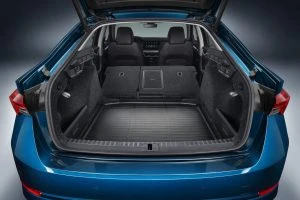
Skoda Octavia Hatchback
Skoda Octavia Hatchback 590 litres
Medium 4-dr Sedan:
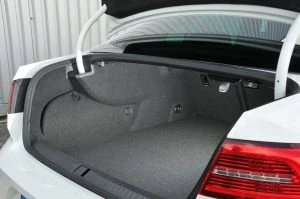
VW Passat Sedan
Volkswagen Passat 586 litres
Skoda Octavia 568 litres
Large 4-dr Sedan
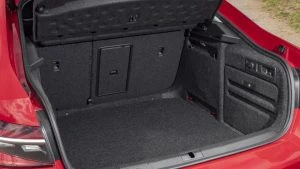
Skoda Superb Sedan/Hatch
Skoda Superb 625 litres
Volkswagen Arteon 563 litres
Station Wagon

Holden Commodore Sportwagon
Holden Sportwagon 895 litres
Skoda Superb 660 litres
Peugeot 308 660 litres
Ford Focus 608 litres
VW Golf 605 litres
Hyundai i30 602 litres
Audi A6 586 litres
Volvo V70 575 litres
BMW 5-Series 570 litres
Jaguar XF 565 litres
Kia Optima 552 litres
Medium SUV
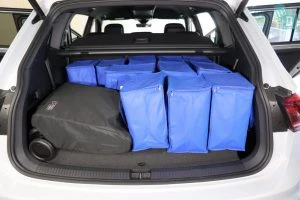
VW Tiguan SUV
Volkswagen Tiguan 615 litres
Toyota RAV4 580 litres
Nissan X-Trail 565 litres
Large SUV
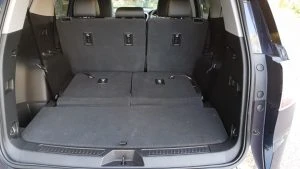
Holden Acadia 7-seater
Holden Acadia 1042 litres
Holden Equinox 846 litres
Mazda CX-9 810 litres
Toyota LandCruiser Prado 620 litres
Hyundai Santa Fe 547 litres